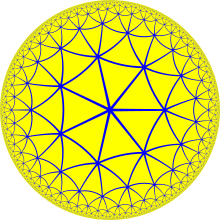
In Riemann surface theory and hyperbolic geometry, a Hurwitz surface, named after Adolf Hurwitz, is a compact Riemann surface with precisely 84(g − 1) automorphisms, where g is the genus of the surface. This number is maximal by virtue of Hurwitz's theorem on automorphisms (Hurwitz 1893). They are also referred to as Hurwitz curves, interpreting them as complex algebraic curves (complex dimension 1 = real dimension 2).
The Fuchsian group of a Hurwitz surface is a finite index torsionfree normal subgroup of the (ordinary) (2,3,7) triangle group. The finite quotient group is precisely the automorphism group.
Automorphisms of complex algebraic curves are orientation-preserving automorphisms of the underlying real surface; if one allows orientation-reversing isometries, this yields a group twice as large, of order 168(g − 1), which is sometimes of interest.
A note on terminology – in this and other contexts, the "(2,3,7) triangle group" most often refers, not to the full triangle group Δ(2,3,7) (the Coxeter group with Schwarz triangle (2,3,7) or a realization as a hyperbolic reflection group), but rather to the ordinary triangle group (the von Dyck group) D(2,3,7) of orientation-preserving maps (the rotation group), which is index 2. The group of complex automorphisms is a quotient of the ordinary (orientation-preserving) triangle group, while the group of (possibly orientation-reversing) isometries is a quotient of the full triangle group.